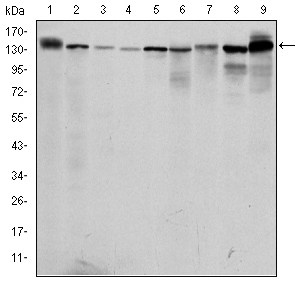PRK2 Monoclonal Antibody
- Catalog No.:YM0534
- Applications:WB;IHC;IF;FCM;ELISA
- Reactivity:Human;Mouse;Rat;Monkey
- Target:
- PRK2
- Fields:
- >>PI3K-Akt signaling pathway;>>NOD-like receptor signaling pathway;>>Yersinia infection
- Gene Name:
- PKN2
- Protein Name:
- Serine/threonine-protein kinase N2
- Human Gene Id:
- 5586
- Human Swiss Prot No:
- Q16513
- Mouse Gene Id:
- 109333
- Mouse Swiss Prot No:
- Q8BWW9
- Rat Swiss Prot No:
- O08874
- Immunogen:
- Purified recombinant fragment of human PRK2 expressed in E. Coli.
- Specificity:
- PRK2 Monoclonal Antibody detects endogenous levels of PRK2 protein.
- Formulation:
- Liquid in PBS containing 50% glycerol, 0.5% BSA and 0.02% sodium azide.
- Source:
- Monoclonal, Mouse
- Dilution:
- WB 1:500 - 1:2000. IHC 1:200 - 1:1000. Flow cytometry: 1:200 - 1:400. ELISA: 1:10000.. IF 1:50-200
- Purification:
- Affinity purification
- Storage Stability:
- -15°C to -25°C/1 year(Do not lower than -25°C)
- Other Name:
- PKN2;PRK2;PRKCL2;Serine/threonine-protein kinase N2;PKN gamma;Protein kinase C-like 2;Protein-kinase C-related kinase 2
- Molecular Weight(Da):
- 112kD
- References:
- 1. Cell. 2009 Jul 23;138(2):389-403.
2. Ann Intern Med. 2009 Apr 21;150(8):541-50.
- Background:
- catalytic activity:ATP + a protein = ADP + a phosphoprotein.,domain:The C1 domain does not bind the diacylglycerol (DAG).,enzyme regulation:Activated by lipids, particularly cardiolipin and to a lesser extent by other acidic phospholipids and unsaturated fatty acids. Two specific sites, Thr-816 (activation loop of the kinase domain) and Thr-958 (turn motif), need to be phosphorylated for its full activation.,function:Exhibits a preference for highly basic protein substrates.,PTM:Activated by limited proteolysis with trypsin.,PTM:Autophosphorylated.,similarity:Belongs to the protein kinase superfamily.,similarity:Belongs to the protein kinase superfamily. AGC Ser/Thr protein kinase family. PKC subfamily.,similarity:Contains 1 AGC-kinase C-terminal domain.,similarity:Contains 1 C2 domain.,similarity:Contains 1 protein kinase domain.,similarity:Contains 3 REM (Hr1) repeats.,
- Function:
- catalytic activity:ATP + a protein = ADP + a phosphoprotein.,domain:The C1 domain does not bind the diacylglycerol (DAG).,enzyme regulation:Activated by lipids, particularly cardiolipin and to a lesser extent by other acidic phospholipids and unsaturated fatty acids. Two specific sites, Thr-816 (activation loop of the kinase domain) and Thr-958 (turn motif), need to be phosphorylated for its full activation.,function:Exhibits a preference for highly basic protein substrates.,PTM:Activated by limited proteolysis with trypsin.,PTM:Autophosphorylated.,similarity:Belongs to the protein kinase superfamily.,similarity:Belongs to the protein kinase superfamily. AGC Ser/Thr protein kinase family. PKC subfamily.,similarity:Contains 1 AGC-kinase C-terminal domain.,similarity:Contains 1 C2 domain.,similarity:Contains 1 protein kinase domain.,similarity:Contains 3 REM (Hr1) repeats.,
- Subcellular Location:
- Cytoplasm . Nucleus . Membrane . Cell projection, lamellipodium . Cytoplasm, cytoskeleton . Cleavage furrow . Midbody . Cell junction . Colocalizes with PTPN13 in lamellipodia-like structures, regions of large actin turnover. Accumulates during telophase at the cleavage furrow and concentrates finally around the midbody in cytokinesis. Recruited to nascent cell-cell contacts at the apical surface of cells. In the course of viral infection, colocalizes with HCV NS5B at perinuclear region in the cytoplasm. .
- Expression:
- Ubiquitous. Expressed in numerous tumor cell lines, especially in bladder tumor cells.
- June 19-2018
- WESTERN IMMUNOBLOTTING PROTOCOL
- June 19-2018
- IMMUNOHISTOCHEMISTRY-PARAFFIN PROTOCOL
- June 19-2018
- IMMUNOFLUORESCENCE PROTOCOL
- September 08-2020
- FLOW-CYTOMEYRT-PROTOCOL
- May 20-2022
- Cell-Based ELISA│解您多样本WB检测之困扰
- July 13-2018
- CELL-BASED-ELISA-PROTOCOL-FOR-ACETYL-PROTEIN
- July 13-2018
- CELL-BASED-ELISA-PROTOCOL-FOR-PHOSPHO-PROTEIN
- July 13-2018
- Antibody-FAQs
- Products Images

- Western Blot analysis using PRK2 Monoclonal Antibody against PC-12 (1), Cos7 (2), K562 (3), Jurkat (4), HeLa (5), A431 (6), C6 (7), NIH/3T3 (8) and HEK293 (9) cell lysate.

- Immunohistochemistry analysis of paraffin-embedded prostate tissues with DAB staining using PRK2 Monoclonal Antibody.

- Flow cytometric analysis of NIH/3T3 cells using PRK2 Monoclonal Antibody (blue) and negative control (red).




